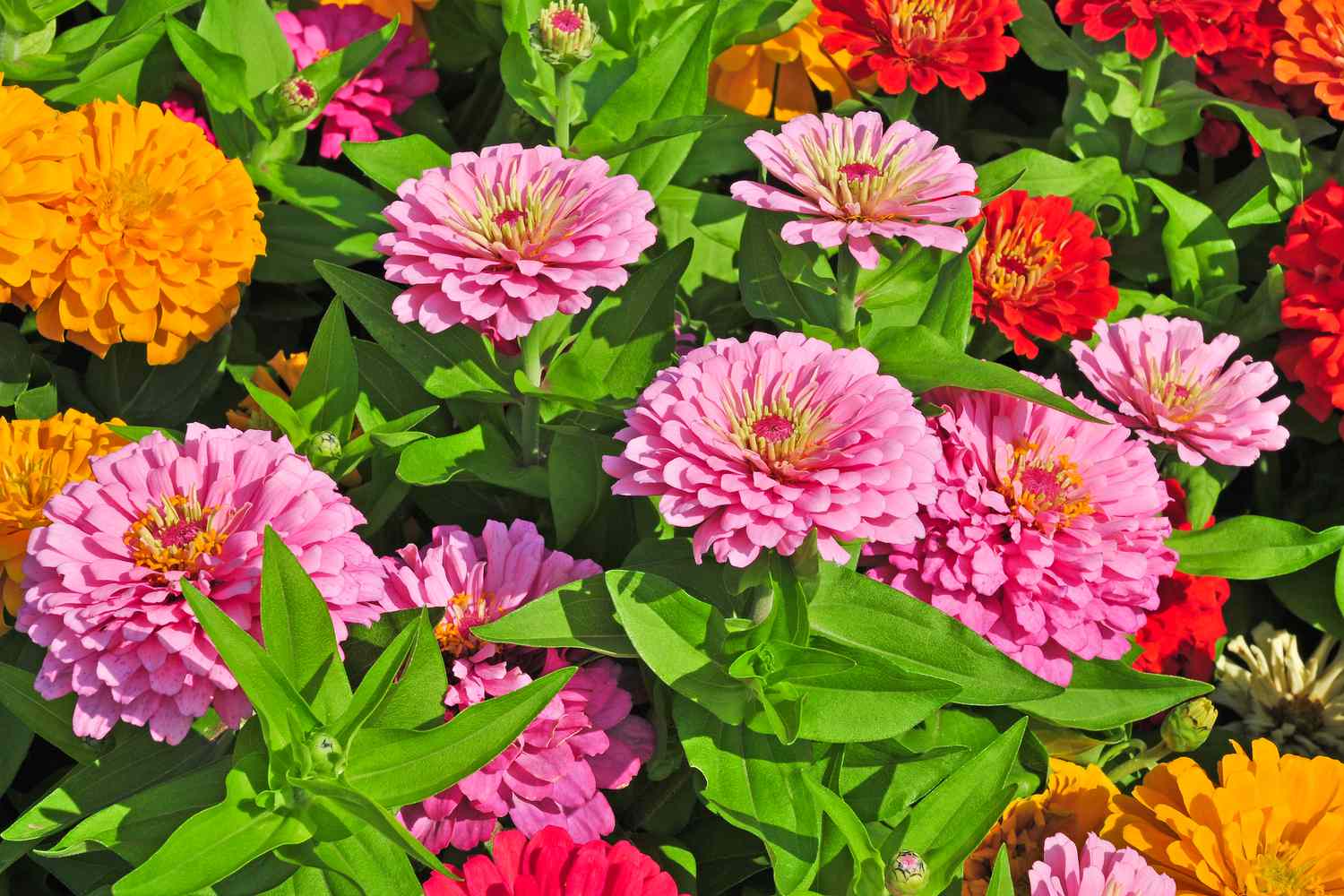Zinnias are annual flowers. This means they only live one growing season and die after they flower.

Zinnia plants perform best in full sun (6 to 8 hours per day). A well-draining site is critical.
Increasing air flow around the plant helps prevent diseases like zinnia blight. This is especially important in areas that experience wet summer conditions.
What are zinnias?

Zinnias are carefree annual flowers with many colors of the rainbow and long-lasting cut stems. They are a pollinator favorite and the perfect flower for the garden and bouquets. Zinnias come in three different floral structures: single, double and semi-double. The differences do not correlate with the plant habit.
Zinnas are prone to powdery mildew and leaf spot but provide plenty of color with regular picking and proper spacing. Zinnias are also susceptible to Japanese beetles and require good vigilance to keep them under control.
Zinnias are very easy to grow from seed or transplants. They germinate quickly and thrive in warm soil. Start seeds indoors or outdoors, set out purchased plants or direct sow them in late spring. Then, once the weather warms, zinnias are a quick and rewarding addition to any garden. Zinnias grow and bloom best in full sun.
How do I grow zinnias?
Zinnias are easy to grow, thriving in warm weather with bright sun and moderate soil moisture. Sow seeds 1/4-inch deep and follow spacing instructions on seed packets. Expect seedlings to appear in 4 to 7 days, then thin them to 6 to 18 inches apart (again depending on variety).

Whether you want 3-inch-wide ‘Benary Giant’ blossoms or fluttery ‘Pop Art’ flowers that resemble gerbera daisies, there are varieties for every purpose. Choose from single, double and semidouble flowerheads. You can also find a few varieties that have both traits – like the ‘State Fair Series’ whose flowers are reminiscent of those on gerbera daisies but with more rows of petals and a clearly visible center. Deadhead spent blooms regularly to promote more flowering and to keep the plants tidy. Zinnias are susceptible to powdery mildew, which causes a dull, whitish film on the leaves and stems, but preventative sprays with Neem oil or Bacillus subtilis can reduce disease problems.
What are the best zinnia varieties?
The best zinnia varieties for cutting and garden borders feature bold, double blooms in bright colors. The All-America Selections winner ‘Queeny Lime Orange’ boasts a dome of ruffled, densely packed shorter petals set off by a skirt of longer ones. It’s a standout in bouquets.
Shorter zinnias like ‘Jazzy Mix’ (Zinnia haageana) feature yellow, cream, orange, and burgundy shades that work well in fall gardens or containers. They grow up to two feet tall with blooms that are 1-2 inches wide.
If you enjoy growing pompon and ball-shaped dahlias, try ‘Purple Prince’ (Zinnia elegans). This variety bears 4in-wide double flowers in shades of magenta, raspberry, tangerine, lemon, dusty lilac, and blush with lavender centers. It is resistant to mildew and drought. It also performs well in pots and window boxes. Its blooms last longer than dinnerplate and collarette-shaped dahlias.
What are the best zinnia colors?
Zinnias come in a wide range of colors and shapes. They are easy to grow and make a great cut flower. They are also very drought tolerant. But if you are growing them in containers, it is best to fertilize them mid season and keep them deadheaded to ensure long stems for cutting.
Matthews recommends ‘Peppermint Stick’, an old heirloom variety with creamy white or yellow blooms striped and speckled in scarlet, red, orange, carmine, and purple. This plant is on the taller side and can reach up to 2.5 feet in height.
Another bold zinnia is ‘Color Crackle’, which has double flowers that look like “round lollipops bursting with color,” Matthews says. This zinnia is resistant to powdery mildew and heat. It grows to a moderate height of 20 to 24 inches and spreads 12 to 14 inches.
What are the best zinnia shapes?
Many zinnia varieties look nothing like garden-variety flowers planted from a packet of seeds, which sets them apart from the generic mix that many backyard growers tend to plant. For example, ‘Oklahoma’ zinnias pack a punch with their huge blooms that resemble rounded lollipops bursting with color. These show-stoppers pair well with rudbeckia (black-eyed Susan) and shasta daisies, plus bee-friendly plants like helianthus or monarda.
Another bold cultivar Matthews recommends is ‘Queen Red Lime,’ which features blooms that begin lime green and open to a limey pink, then fade to purplish red. This type of zinnia requires full sun and rich, well-drained soil and makes an excellent choice for a cutting garden or for showcasing in a mixed border. For added height, partner it with taller scabious, echinacea, aquilegia, agastache or pincushion flower varieties. It’s also a stunning addition to bouquets.
What are the best zinnia hybrids?
There are many hybrid zinnia varieties available, making it easy to find your perfect color. Zinnias are easy to grow and provide reliable summer color. Generally, they need full sun and a well-draining soil with consistent moisture. Plants may need regular watering and fertilizing to keep them blooming throughout the summer. Zinnias are susceptible to powdery mildew, but you can help prevent it by planting disease-resistant varieties and spacing plants further apart to allow for good air flow.
Gardeners love heirloom zinnias for their crayon-bright colors and fabulous shapes. They are a staple in cut flower gardens, and they thrive as part of mixed plantings. They also attract pollinators and make a great choice for interplanting in vegetable gardens. These annual flowers are so easy to grow that they’re almost a no-brainer for any sunny garden!
What are the best zinnia seeds?
There are zinnia seeds in every shape, color, and size imaginable. A plethora of options allows growers to select the perfect flower for each sunny garden.
A Fleuroselect winner, ‘Mazurkia’ adds an unexpected twist to the classic zinnia with its fun campy double flowers that boast lipstick-pink centers and soft blush tips. It’s also a snap to grow, thriving in heat and tolerates frost well.
For cutting, the taller varieties like ‘Benary Giants’ work best, especially when they are pinch-pruned regularly to focus energy into producing more blooms and longer stems. To determine if the plant is ready to harvest, use the “wiggle test”: If it droops or bends easily, it’s not ripe yet. The compact ‘Oklahoma’ series is another standout for growing in containers and garden beds, with 2-inch flower heads that resemble round lollipops bursting with color.
What are the best zinnia plants?
Zinnias make excellent cut flowers, and they work well as supporting or secondary blooms in bouquets. They’re also great for edging the garden or planting in containers. Look for compact varieties like Profusion and Dreamland, which don’t skimp on flower size — they have 4″ double blooms with burgundy-red or raspberry-red centers and creamy white petal tips.
Tall zinnias such as the Benary Giant series have large blooms that can grow up to 4-5 inches wide. They are ready to be cut for bouquets when they pass the “wiggle test” – grab them about 8″ down from the flower and gently shake them. If the petals stay rigid, they’re ready to be used.
The best zinnia plants are those that tolerate heat and have good air circulation, which helps to prevent problems like powdery mildew and bacterial wilt. They also require full sun and loose, well-draining soil.
What are the best zinnia plants for heat?
Traditionally, gardeners have been advised to stick with single-flowered, flatheaded types because they are easier for pollinators to access the nectar. But new anecdotal and controlled research has shown that pollinators can be just as drawn to other zinnia bloom shapes and colors, particularly tall varieties.
Zinnias come in a variety of heights, from dwarf singles to soaring four- to five-foot-tall hybrids. For a midsize choice, try ‘Macarenia’ (Zinnia angustifolia x Zinnia elegans), which won the Fleuroselect Novelty award in 2012. Each glowing scarlet petal is tipped in gold for a fun twist.
Whether you are growing zinnias for cutting or just enjoy them in the garden, it’s a good idea to mulch the soil to moderate temperature and keep roots happy and cool. Regular watering and weed control will also help. If Jack Frost is prowling, a frost blanket can protect plants like a warm hug.
What are the best zinnia plants for cold?
When Zinnias get stressed (think hot weather or frost), they often stop producing blooms and turn yellow. Leaves can also droop or curl, a sign that they are conserving moisture as they wilt. Luckily, a few measures can prevent these conditions from impacting your garden.
Mulching can keep roots insulated from temperature extremes, while frequent irrigation will make plants less susceptible to droughts. You can also deadhead spent flowers regularly to help plants focus energy into producing new blooms. Zinnia breeders have had a field day with the classic daisylike form, creating a wide variety of single, double, and dahlia-flowered cultivars in a myriad of colors, sizes, and heights. For a fun twist, try the Fleuroselect winner ‘Macarenia’, which features glowing scarlet petals tipped in gold. There are even midsize hybrids like ‘Oklahoma Salmon’ that resist the scourge of powdery mildew.

1 thought on “What Are Zinnias?”